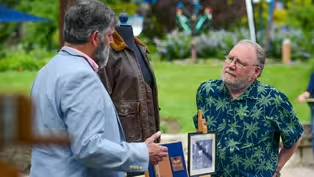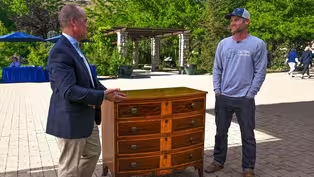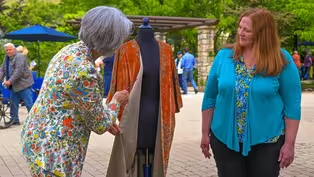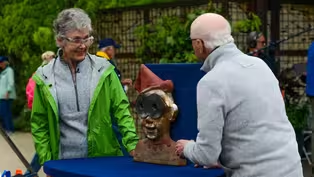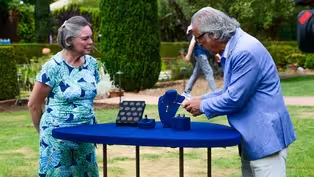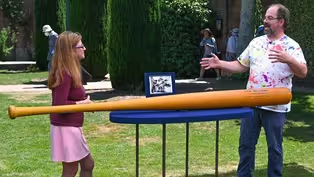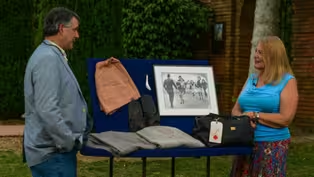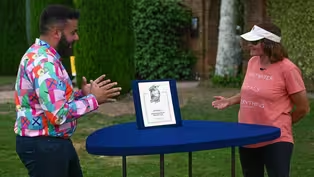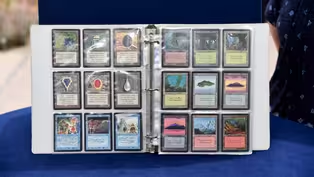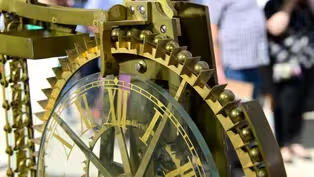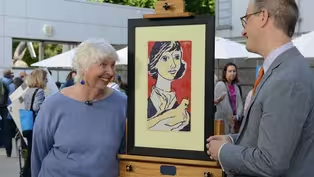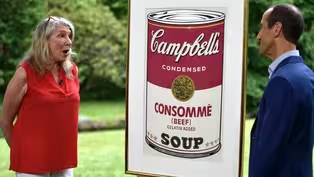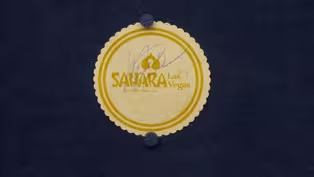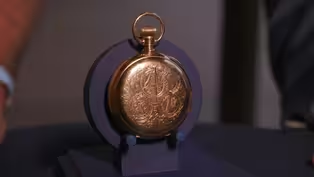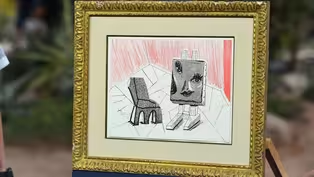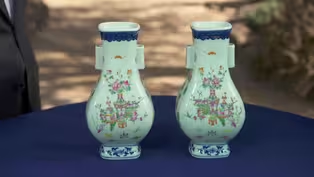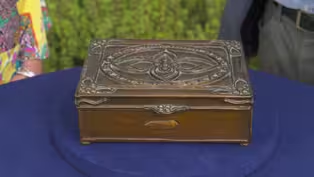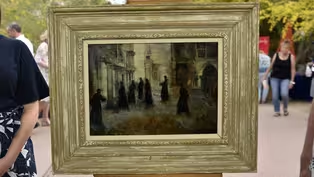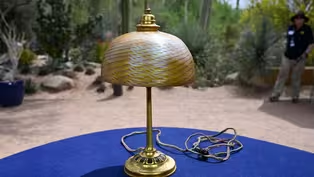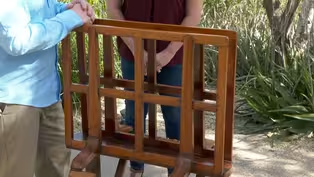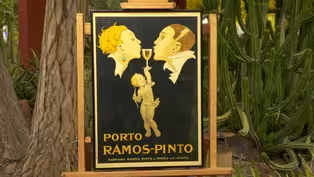
RECUT: Desert Botanical Garden, Part 2
Special | 22m 28sVideo has Closed Captions
Phoenix treasures heat up, like one appraisal up to $35,000, in this half-hour RECUT!
Phoenix treasures heat up in this half-hour RECUT, including a 1955 Humphrey Bogart-signed Yankee Stadium menu, a Louis C. Tiffany Furnaces, Inc. table lamp, and an 1889 William McKinley presentation watch. Which treasure is up to $35,000?
Problems playing video? | Closed Captioning Feedback
Problems playing video? | Closed Captioning Feedback
Funding for ANTIQUES ROADSHOW is provided by Ancestry and American Cruise Lines. Additional funding is provided by public television viewers.

RECUT: Desert Botanical Garden, Part 2
Special | 22m 28sVideo has Closed Captions
Phoenix treasures heat up in this half-hour RECUT, including a 1955 Humphrey Bogart-signed Yankee Stadium menu, a Louis C. Tiffany Furnaces, Inc. table lamp, and an 1889 William McKinley presentation watch. Which treasure is up to $35,000?
Problems playing video? | Closed Captioning Feedback
How to Watch Antiques Roadshow
Antiques Roadshow is available to stream on pbs.org and the free PBS App, available on iPhone, Apple TV, Android TV, Android smartphones, Amazon Fire TV, Amazon Fire Tablet, Roku, Samsung Smart TV, and Vizio.
Buy Now
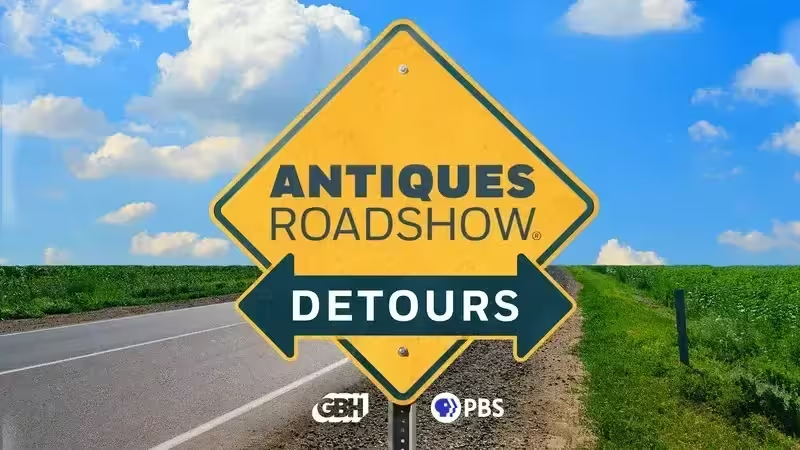
ANTIQUES ROADSHOW DETOURS
Ever wondered what happens to the treasures featured on America’s beloved ANTIQUES ROADSHOW after the cameras leave town? Host Adam Monahan tracks down the juicy afterlives of your favorite finds from PBS’s hit series.Providing Support for PBS.org
Learn Moreabout PBS online sponsorshipMore from This Collection
America’s favorite treasure hunt ANTIQUES ROADSHOW presents a bite-sized way to enjoy the show. ANTIQUES ROADSHOW RECUT features thirty-minute episodes, packed full of favorite finds and paced for maximum entertainment. RECUT features episodes recut from the show’s previous visits to distinctive and historic locations across the country.
RECUT: Idaho Botanical Garden, Part 4
Video has Closed Captions
Wrap up Season 4 of RECUT with a $50,000 appraisal at Idaho Botanical Garden! (22m 31s)
RECUT: Idaho Botanical Garden, Part 3
Video has Closed Captions
Visit the “City of Trees” for unbe-leaf-able Boise treasures in this half-hour RECUT. (22m 31s)
RECUT: Idaho Botanical Garden, Part 2
Video has Closed Captions
In this half-hour RECUT, watch breathtaking Boise appraisals at Idaho Botanical Garden. (22m 31s)
RECUT: Idaho Botanical Garden, Part 1
Video has Closed Captions
Gem State treasures sparkle in this half-hour RECUT at Idaho Botanical Garden! (22m 31s)
Video has Closed Captions
Watch wow-worthy Woodside finds in this half-hour RECUT and learn which is up to $44,000! (22m 24s)
Video has Closed Captions
In this half-hour RECUT episode, golden state treasures shine at Filoli. One is $150,000! (22m 23s)
Video has Closed Captions
Watch fascinating Filoli finds in this half-hour RECUT, including one up to $100,000! (22m 36s)
Video has Closed Captions
This season's first half-hour of RECUT wows our guests with a $200,000 to $330,000 find! (22m 30s)
RECUT: Desert Botanical Garden, Part 1
Video has Closed Captions
Phenomenal Phoenix finds abound in this half-hour RECUT. One is worth up to $100,000! (22m 26s)
RECUT: Crocker Art Museum, Part 2
Video has Closed Captions
See stunning Sacramento finds like one $80,000-$125,000 treasure, in this half-hour RECUT! (22m 28s)
RECUT: Crocker Art Museum, Part 1
Video has Closed Captions
Head to California’s Crocker Art Museum for a bite-sized RECUT! One find is up to $75,000! (22m 27s)
RECUT: Winterthur Museum, Garden & Library, Part 2
Video has Closed Captions
Discover Delaware treasures in this half-hour RECUT, including one valued at $50,000! (22m 27s)
Providing Support for PBS.org
Learn Moreabout PBS online sponsorship♪ ♪ CORAL PEÑA: "Antiques Roadshow Recut" returns to the Desert Botanical Garden in Phoenix, Arizona.
MAN: My wife brought it home and I said, "What is that?"
MAN: This is the pocket watch of my great-great-uncle President William McKinley.
♪ ♪ PEÑA: It's morning in the Sonoran Desert, and "Antiques Roadshow" is ready for a busy day.
Ready to greet thousands of people who've come to the Desert Botanical Garden to discover something new about their old treasures.
While the cactus flowers bloom as the sun climbs, let's see what our experts have unearthed.
♪ ♪ WOMAN: I brought my great-great- grandparents' stratosphere violin from the old country in Sweden.
We believe this one would, could possibly be real.
So we'll see.
MAN: We bought it in New Zealand three years ago.
It's a knife box, and we didn't see any marks on it, so we don't know really any more about it.
It is Georgian, from about 1790.
The color is great.
It's really nicely done.
What did you pay for it?
WOMAN: $800 At auction, we expect to see about that.
So, in a high-end retail store, you could have paid four times that.
(chuckling): So I think you did very well.
Okay, cool.
It's a beautiful thing.
Cool.
Thank you very much.
Thank you.
I was taking a walk in the morning, and I got about four houses down from where I live, and there was a sign that said "free."
And so I walked by it the first day, and then the second day, I thought about it again, and I thought, "Well, I'll take this, "and it's pretty ugly, but I can give it to somebody, but it's a lamp, so I'll just take it."
So, when I brought it home, I ran over to my neighbor and asked him if he could cut the cord off and fix it.
He said the plug alone is really old, and that I should wait and find out about the lamp before I cut it off.
He could always cut it off if I wanted to, but I should wait and find out about it before I do.
Okay, so, I'm going to tell you about your lamp.
It is a Louis Comfort Tiffany lamp.
It's actually made by Louis C. Tiffany Furnaces, Inc., which is one of the names of Louis Comfort Tiffany's companies.
He had several names starting in the late 1870s, going into the early 1930s.
This is the next-to-last name of the company.
So, this would date from 1920 to about 1928.
Oh, my God.
And you have a gilded-bronze base with the enamel design around the foot, and then what we call a damascene blown-glass shade with wonderful iridescence on the outside.
These came in several different colors, and there's sort of a hierarchy of value in the colors.
This one is the caramel color.
Something like this is very desirable because it's intact, and the shade is one of the better colors.
This comes off.
Okay.
And then... here.
Oh, yeah.
Oh, yeah!
It says "L.C.T.
Favrile."
Okay.
And fav, favrile meant, to Tiffany, it was his trademark word for handmade.
This is first, and then see... Oh, yeah, second.
...this covers it, which is nice, 'cause that covers the edge.
In a retail venue, something like this could sell for between $10,000 and $15,000.
(gasping): Oh, my God.
You definitely want to get it rewired, because there's absolutely no value in original wiring.
Okay.
And please, don't ever transport it in one, in one piece with the shade on, like you did, because the bulk of the value is in this shade.
(sniffles) And if you broke the shade, the base would be worth about $500 to $1,000.
So the shade is very important.
♪ ♪ It's 1952.
The postwar baby boom is well underway.
Soldiers came back, they got married, they bought a bungalow in L.A., and they're having kids.
They want pretty, decorative things.
They don't have any money.
So this cottage industry kicked in, where American companies were making attractive, inexpensive decorative pottery for these homes.
The Japanese saw that, they started producing these things for a fraction of the price.
APPRAISER: These are Pima baskets.
WOMAN: Pima?
And it's, uh, they're beautiful.
Aren't they?
Nice designs.
And they were made for sale, for the tourist trade.
Oh, were they?
Mm-hmm.
I would say at auction, these would sell for about $1,200.
Oh, really?
As a unit.
All right, thank you.
Yeah, no problem.
My mother was a caregiver for an elderly woman for 35 years or so.
And she's willed a couple of things to us.
Do you actually know what it is?
It's a portfolio stand, and I'm understanding that you put portraits in here.
It is, in fact, a display folio stand, or a portfolio stand.
It's actually really used for large books.
This was made probably just around 1810 or 1815, during a part of the Regency period.
This is a period in England that showed very explosive growth and a lot of wealth.
And this is a perfect example of something that a wealthy person would have purchased.
During this time period, you had very large books.
It's sort of a, a macho thing to have.
You know, it's, like, "I've got big books, so I need something to be able to display them with."
It moves down like this.
And that way, you can put the book in the middle of it, and then you're able to turn the pages.
And more importantly, what this actually did was, it saved the spine of the book.
And you're able to put it up at the end.
A lot of those are made in mahogany.
This one is actually made in rosewood.
In today's market, if you saw this in an auction house, I would probably say you would see an estimate of around $2,000 to $3,000 on it.
Okay, that's nice.
Now you're on a mission.
(laughing) Now you got to find a big-ass book and put it in there, so... (laughs) ♪ ♪ PEÑA: This grouping of Dale Chihuly glass sculptures, "Desert Towers," created in 2008, was part of a larger Chihuly exhibit at the garden that ended in May of 2009.
Afterwards, a successful fundraising campaign allowed the garden to add the pieces to its permanent art collection.
♪ ♪ MAN: About 15 or 20 years ago, I, uh, went into a church rummage sale, and I, I just noticed these quite quickly, and I, I was drawn to them, decided to buy them.
Okay.
What did you pay at the rummage sale?
I paid, I believe, $20.
This particular shape is a shape that developed in China.
It's derived from bronze ritual vessels made roughly around 1000 BC, and it's a form called a hu, H-U.
We're going to look at the underside, and we see that there is this iron red.
Mm-hmm.
And it's a six-character mark that says it was made during the reign of the Qianlong emperor.
Wow.
1735 to 1796.
Are you serious?
That's what it says.
Wow.
However, we also have...
This right here is a particular color that was favored by the empress of China, the de facto empress, whose name was Cixi, who reigned toward the lend, end of the 19th century and into the early 20th century.
And she loved this kind of color combi, combination of aubergine and turquoise.
Okay.
And so that's a clue as to what kind of date we're looking at.
So we have a conflict.
Okay.
One of the other things that we look to for dating is the color of the blue.
20th century is more common for that kind of coloration than earlier periods.
I see, okay.
So, what we see from the combination of the enamel decoration, the way that the scenes are drawn, you have something that dates from the 20th century.
Do you want to hazard a guess what these might be worth?
Maybe $300 or $400?
I think a little bit more.
More like about $600 to $900.
Oh, wow.
At auction.
And you paid?
I paid $20.
I think that's pretty good.
(laughs) Yeah, I do, too, I'm happy.
MAN: Five years ago, my wife had the foresight to acquire it, and, uh, she went to a local coin shop, where she was trying to find a coin minted in the year that her father was born, because it was a big birthday.
And she got the coins, and as she was headed out-- because this was also, uh, a pawn shop-- she happened to see this picture hanging there.
Uh, she didn't know anything about it, but she thought it was very whimsical, because of the characters.
And so she bought it, brought it home.
I believe it was about $130.
I looked at it, and I said, "Hmm."
Uh...
But then, uh, I took a look at, uh, the signature, and last year, when there was a big sale of one of his paintings that set a record, I thought, "Well, we need to find out a little bit more about it."
So you know the artist is David Hockney.
Yes.
He's probably the most famous living English artist.
Mm-hmm.
Lives between England and Southern California.
Right.
He's been working in printmaking since the 1950s.
Mm-hmm.
Making lithographs, etchings, screen prints, both in, in Europe and in the United States.
And by this midpoint in his career, in the 1980s, this, 1985, 1986, he turned away from the traditional printmaking technique of working with a workshop to produce a lithograph or an etching, and numerous people who are involved in that, to going all on his own to make these handmade photocopy prints.
And that's what this is.
Photocopies, very cool.
It's a deluxe color photocopy.
In order to do this, he would make several drawings, one for each of the colors.
The red color, he'd put that on the photocopier... Mm-hmm.
Run a piece of paper through, print the red.
Mm-hmm.
And then put that paper back in the tray.
Okay.
Put the black part of the drawing on and run that through the photocopier.
Interesting.
So it's not just a drawing thrown on the photocopier.
Right, right-- right.
'Cause that, that, he, he figured, correctly, would look too flat.
Mm-hmm.
This way, with the numerous photocopies on one sheet, you get more of an artful-looking print.
Okay.
You can see that it's a limited edition numbered in the lower left.
It's signed by the artist, dated, and then it has a blind stamp in the lower right, too.
And he's put that there just because he is both the artist and, in this case, the publisher.
It looks like the colors are in great shape.
It looks just as it might have when it was created.
And it shows his admiration for and the influence of Picasso on his work.
I believe it's called "Chair With Celia" or something.
Is this Celia?
And... Yeah.
Celia was a friend of his.
She was a designer, an English designer.
And he made numerous portraits of her from the 1960s on through.
Okay-- I'm sure she's more attractive than that, though.
(laughs) It's nice, high-career David Hockney.
And you, you had no expectations whatsoever... None at all-- my wife brought it home, and I said, "What is that?"
And then you see on the news that...
Yes.
...he sells a painting at auction for $90 million.
For $90 million.
And I'm sure you're, like, "Oh, "we've got that Hockney over there on the wall.
I wonder what that's worth today."
Yeah, yeah, I kind of made that connection, yes.
At auction, in this condition, which is mint, I would say, near-perfect... Wow, okay.
...I would put an estimate of $7,000 to $10,000 on this.
Oh, my gosh.
So... That's wonderful.
Not bad for a coin shop/ pawn shop purchase.
Not, not bad at all.
I guess the lesson is to, to always listen to what your wife tells you.
When Truman was president, they rebuilt the White House, and what they didn't use, they gave to anybody that sent in a fee for shipping and handling, and my brother sent in for one of the artifacts, and, uh, he gave it to me.
I've seen a lot of the things from the White House renovation.
Mostly what I see are nails and bits of glass and then rocks and things like that.
But I've never seen a brick, and I've never seen one in its original box with the postage.
This has got the plaque, it's got a great look.
Full brick and the box is easily at auction a $600 item.
Okay.
So pretty cool, and I'm psyched to see you brought it in.
Okay, thank you.
MAN: I was visiting Las Vegas the summer of '86.
The University of Nevada- Las Vegas and University of North Carolina played an alumni basketball game.
After the game was over, I was in the casino, and Michael Jordan and the rest of the team came back.
I saw them sit down at a table, and I sat down at the table with them.
(chuckles) What did you guys play, poker?
Blackjack.
Blackjack, okay.
How did he play?
He played okay.
At first we all, we were all winning, and then he upped his bet, and, uh, we all started losing.
You had your opportunity.
You wanted an autograph, so you went ahead and you went for it.
I... when he was leaving the table, I asked him, yes.
Looks like he found a blue ballpoint pen, he did his, his typical, usual Michael Jordan autograph right on this paper coaster.
So, '86, he got hurt early in the season.
He broke his foot, and he came back the same season.
Yes.
The Bulls, when Jordan returned, finished with a 30-and-52 record and still made the playoffs.
If we're giving it a grade, it looks about an eight.
Okay.
On a, on a one-to-ten scale.
Overall, great piece.
At auction, probably fetches somewhere between $2,000 to $3,000.
Oh, wow, very good, wow.
Thank you.
(chuckles) Pretty neat.
MAN: I brought this painting by Grigory Gluckmann.
About ten years ago, I bought it at a estate auction.
I thought it was a beautiful painting.
I didn't know anything at all about it, but it was intriguing.
And do you remember what you paid at the estate sale?
I'm not exactly sure, but it was probably be, somewhere between $500 and $750.
And I looked up the, this guy on the internet, and I found lots of examples of his work.
But most of the pieces that I saw on the internet didn't look anything at all like this.
So I wasn't sure if this is an actual Gluckmann painting or not.
A lot of his paintings have, like, ballet dancers or nudes, voluptuous women.
And this is, it's kind of a macabre painting where it's dark, it's kind of dank, and you don't know exactly what's happening in the painting.
So it is a painting by Grigory Gluckmann.
He was a Russian artist.
He studied in Moscow, and he escaped the Russian Revolution and moved to Berlin.
He showed at many important galleries in Paris.
And in 1945, he moved to Los Angeles.
I would estimate that the date of this painting is circa 1950.
Now, there's a few ways that we know that this painting is an authentic Grigory Gluckmann painting.
Mm-hmm.
One of those ways is the Los Angeles connection.
Mm-hmm.
There is a label on the back... Mm-hmm.
...from Dalzell Hatfield Galleries, which was the most prestigious gallery in Los Angeles during the time that he moved there.
It sold artists like Pablo Picasso and Georges Braque.
And all the Hollywood celebrities went there to buy art.
And that's really how he became popular in America.
And we have the authentic label from that gallery of the price tag of $1,500.
Mm-hmm.
The other way that we know this is an authentic Gluckmann painting is because of the style.
So, you mentioned that you saw some different subjects by this artist.
And he really is known for painting ballerinas and women.
That sort of thing is sort of quintessential Gluckmann.
However, the technique used here in this painting is just like his paintings of ballerinas.
He took the techniques he learned in Moscow and continued to use them.
He painted on board.
He painted in very thin layers, which took a lot of time to produce.
And that effect was really to make the paintings look soft and kind of moody, which is exactly what we have here.
It's just that it's a different subject.
Did he do most of his paintings oil on board?
Yes.
So we do have a signature, "Gluckmann," in the lower left.
But the real signature here is the style of the painting.
Mm-hmm.
Today at auction, we would estimate this painting at $8,000 to $12,000.
That's wonderful.
That's what...
It's a good investment.
(chuckles) MAN: Well, I got this World Series Yankee Stadium Club menu... APPRAISER: Mm-hmm.
...from my neighbor who lived across the street from me.
And she was a cashier at the Stadium Club during the '55 World Series.
Humphrey Bogart happened to be in the Stadium Club.
She asked him for his autograph.
So, he grabbed the menu and signed his autograph on the back of the menu, yeah.
Well, Bogart was a baseball fan through and through.
I would probably put an auction estimate here of probably about $1,500 to $2,500 on it.
Wow.
And if I was going to...
I said I wasn't going to say, "Wow."
Great, terrific, terrific.
And you did.
And I did, I did.
And if you're going to insure it, I'd put $5,000 on it.
Okay, great.
Because it's got to be one of a kind.
♪ ♪ PEÑA: There are plants in the Desert Botanical Garden that are thought to have medicinal properties to aid in a variety of health issues.
Some say yerba mansa can be used to treat cold symptoms, that the bark of Salix willow trees is good for pain, and that prickly pear cactus can be used for diabetes and hangovers.
♪ ♪ MAN: This is the pocket watch of President William McKinley.
He's my great-great-uncle.
It's just been passed down from generation to generation.
I've had it for about six years, and it's been in a, uh, safety deposit box ever since.
It's a Hampden from the Dueber-Hampden Watch Company of Canton, Ohio.
Okay.
It's a solid 18-karat-gold case.
It's a high-jeweled movement, and we see on the outside, it's got the initials of President McKinley.
There's a phenomenal presentation.
It is crisp and clean.
It looks like this was engraved yesterday.
This watch was given to him at the time that he was governor of the State of Ohio.
The Dueber-Hampden Watch Company of Canton, Ohio, gave him one of the best watches you could hope to get... Wow.
...that came out of their factory.
He was our 25th president.
Mm-hmm.
And you know a little more.
He was assassinated.
1901.
In 1901.
Six months into his second term in office, very sad, very tragic.
What we got here is a crossover collectible.
Not only would watch people go crazy for this-- and it's a great American collectible watch-- it's a politically important piece of Americana and American history.
In a retail setting, this watch should bring easily $30,000 to $35,000.
Really?
Wow.
I was thinking $1,000 or $2,000.
My mom used to wear it, put it on a chain and wear it to cocktail parties.
WOMAN: I purchased it in 1972 at a flea market in Paris.
I worked for Pan Am at the time as a flight attendant, and I would go over about four times a month, and I started collecting the posters.
I could, uh, roll them up and carry them on the plane in a tube.
They were easy to transport.
And on one of the trips, I saw this poster, and it was a lot smaller than the other ones I had been buying.
But the dealer assured me that it was a genuine vintage poster.
About 15 years ago, I started seeing a lot of these images on posters in stores for, like, $20, and they were really big.
And that concerned me.
And at the flea market, how much did you pay for it?
$30.
Which at the time, in '72, was a lot.
It's this wonderfully romantic, Valentine's-y image... Mm-hmm.
...with little Cupid with his bow holding up a glass of port for these two archly Art Deco lovers, who are, they're trying to kiss, and Cupid's, like, "No, you've got to get drunk first."
It's compelling and so well-composed, too, how our, our attention is drawn right to the center of the image.
It's a masterpiece of graphic design.
It's interesting that you've seen bigger copies.
Mm-hmm.
And you worried that the small one might be a reproduction.
Right, or might devaluate it because of that.
In fact, it's the absolute opposite.
The, this was only ever done in a small format, and all of the bigger ones... Mm-hmm.
...are reproductions.
Ah-hah.
And so this is an original.
Mm-hmm.
It dates to the 1920s.
Mm-hmm.
It's by René Vincent, who was one of the great Art Deco poster artists of the era.
He did a lot of advertisements for Peugeot.
Wow.
And for different department stores.
Mm-hmm.
This one is one of his best-known images, specifically because they printed so many copies of the poster.
Because it was small... Mm-hmm.
...not only was it easy for you to carry on a plane, but they could print a lot, and they could store a lot.
Uh-huh.
So a lot of the originals have survived.
Mm-hmm.
But at its high-water mark, this piece has sold for as much as $1,600 at auction.
Hmm, really, wow.
I would say, in the current climate, a more realistic auction estimate would be between $800 and $1,200.
Wow, okay, so, so, it is real.
So, it is real, it's wonderful.
Hmm.
PEÑA: Thanks for watching.
See you next time on "Antiques Roadshow Recut."
Appraisal: 1986 Michael Jordan-signed Casino Coaster
Video has Closed Captions
Clip: Special | 1m 23s | Appraisal: 1986 Michael Jordan-signed Casino Coaster (1m 23s)
Appraisal: 1889 President McKinley Presentation Watch
Video has Closed Captions
Clip: Special | 1m 45s | Appraisal: 1889 President McKinley Presentation Watch (1m 45s)
Appraisal: 1986 David Hockney "Celia with Chair" Print
Video has Closed Captions
Clip: Special | 3m 34s | Appraisal: 1986 David Hockney "Celia with Chair" Print (3m 34s)
Appraisal: Chinese Vases, ca. 1930
Video has Closed Captions
Clip: Special | 1m 56s | Appraisal: Chinese Vases, ca. 1930 (1m 56s)
Appraisal: Fake Tiffany Bronze Casket, ca. 1980
Video has Closed Captions
Clip: Special | 1m 59s | Appraisal: Fake Tiffany Bronze Casket, ca. 1980 (1m 59s)
Appraisal: Grigory Gluckman Oil Painting, ca. 1950
Video has Closed Captions
Clip: Special | 3m 26s | Appraisal: Grigory Gluckman "Porta Carta" Oil Painting, ca. 1950 (3m 26s)
Appraisal: Louis C. Tiffany Inc. Lamp, ca. 1925
Video has Closed Captions
Clip: Special | 2m 46s | Appraisal: Louis C. Tiffany Furnaces, Inc. Table Lamp, ca. 1925 (2m 46s)
Appraisal: Regency Rosewood Folio Stand, ca. 1810
Video has Closed Captions
Clip: Special | 1m 36s | Appraisal: Regency Rosewood Folio Stand, ca. 1810 (1m 36s)
Appraisal: René Vincent "Porto Ramos-Pinto" Poster, ca. 1920
Video has Closed Captions
Clip: Special | 2m 19s | Appraisal: René Vincent "Porto Ramos-Pinto" Poster, ca. 1920 (2m 19s)
Providing Support for PBS.org
Learn Moreabout PBS online sponsorship
- Home and How To

Hit the road in a classic car for a tour through Great Britain with two antiques experts.













Support for PBS provided by:
Funding for ANTIQUES ROADSHOW is provided by Ancestry and American Cruise Lines. Additional funding is provided by public television viewers.


